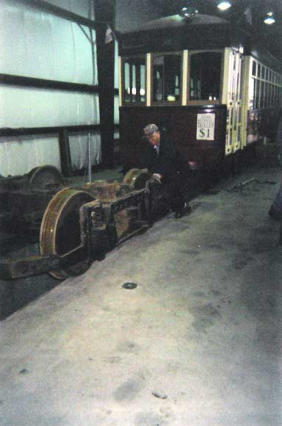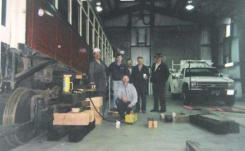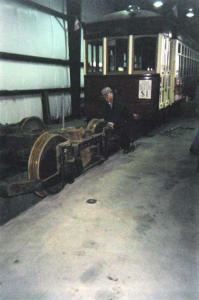




ASTORIA RIVERFRONT TROLLEY


Copyright ©2026 Astoria Riverfront Trolley Association Astoria, Oregon

About
Trolley History
Old 300 was built in 1913 by the American Car Company of St. Louis, Mo., for the San Antonio Traction Company in Texas. This group of cars was numbered 300 to 313 and had composite car bodies constructed from both wood and steel. Similar cars, 314 – 325, came from American Car in 1914 and had steel bodies. In 1917 the San Antonio Traction Co. became part of The San Antonio Public Service Co. Streetcar service in San Antonio officially ended April 29, 1933, though some cars remained in service occasionally through the July 4th weekend. This was due to the slow delivery of new buses and a higher than expected rate of breakdowns of buses. Car 300 was presented to the Witte Museum on Sunday, April 29, 1933, with great fanfare. The car was run onto the museum grounds under its own power and parked. (Witte Museum is the precursor, and an important part now, of the San Antonio Museum Association.) Old 300 was left outside, with little maintenance, until 1948. It then received housing and a superficial restoration, including filling rotted areas with plaster. Traction motors, air compressor, and resistors were loaned out to another operation during World War II and never returned. In 1968, after the San Antonio World’s Fair, a Transportation Museum was developed at the downtown fairground. Car 300 was again placed on outdoor, unsheltered display until 1980, by which time it had a rather terminal case of rot. The initial 1980-81 restoration ultimately required the use of car body 311, which had been scrapped in 1933. It had been placed under a metal shed and served as a woman’s residence until 1978, when she entered a rest home. Mrs. Rhoda Billings donated her home for this restoration. 300’s interior fittings and brass window sashes were used in this restoration. Broad-gauge New Orleans trucks and traction motors were acquired in Shreveport and “standard gauged,” which means that the wheels were spaced 4’ 8 1/2” apart to fit on standard tracks. The original 4-foot gauge trucks are held by San Antonio Car Co. to place under another San Antonio car to be restored. For about five years, Old 300 ran on the Willamette Shore Trolley line from Portland to Lake Oswego. Then for the next five years the trolley went to Gales Creek, where another restoration was begun and Old 300 ran at the Glenwood Trolley Park. The Glenwood Trolley Park was shutting down operations when the City of Astoria was made aware of the availability of Old 300. Old 300 was leased from San Antonio for five years at $1 per year and brought to the MERTS facility in December 1998 for restoration. A makeshift shed behind City Lumber, East of the Barbey Center, was her home/maintenance shed until the completion of the current Trolley Barn in 2002. The Mill Pond trestle served as the “pit” In 2005, the Riverfront Trolley Association (RTA) was able to purchase Old 300 at the last minute before the SAMoA was set to auction her off, saving what had become an Astoria icon. The restoration of Old 300 was completed by an all-volunteer group of Astoria residents during the first five months of 1999. Considerable wood rot on one side below the windows was repaired. The exterior canvas roof of the trolley was re-covered, the interior bead-board ceiling installed, and the electrical systems repaired. The interior and exterior were painted. A diesel generator was acquired, and the generator trailer fabricated. More than $20,000 was raised (and spent), and nearly 3,000 man-hours were donated. As motormen and conductors, we all share a burden of responsibility not only for the safety of our passengers, but also for the continued preservation of Old 300.

ASTORIA RIVERFRONT TROLLEY


Copyright ©2025 Astoria Riverfront Trolley
Association Astoria, Oregon

About
Trolley History
Old 300 was built in 1913 by the American Car Company of St. Louis, Mo., for the San Antonio Traction Company in Texas. This group of cars was numbered 300 to 313 and had composite car bodies constructed from both wood and steel. Similar cars, 314 – 325, came from American Car in 1914 and had steel bodies. In 1917 the San Antonio Traction Co. became part of The San Antonio Public Service Co. Streetcar service in San Antonio officially ended April 29, 1933, though some cars remained in service occasionally through the July 4th weekend. This was due to the slow delivery of new buses and a higher than expected rate of breakdowns of buses. Car 300 was presented to the Witte Museum on Sunday, April 29, 1933, with great fanfare. The car was run onto the museum grounds under its own power and parked. (Witte Museum is the precursor, and an important part now, of the San Antonio Museum Association.) Old 300 was left outside, with little maintenance, until 1948. It then received housing and a superficial restoration, including filling rotted areas with plaster. Traction motors, air compressor, and resistors were loaned out to another operation during World War II and never returned. In 1968, after the San Antonio World’s Fair, a Transportation Museum was developed at the downtown fairground. Car 300 was again placed on outdoor, unsheltered display until 1980, by which time it had a rather terminal case of rot. The initial 1980-81 restoration ultimately required the use of car body 311, which had been scrapped in 1933. It had been placed under a metal shed and served as a woman’s residence until 1978, when she entered a rest home. Mrs. Rhoda Billings donated her home for this restoration. 300’s interior fittings and brass window sashes were used in this restoration. Broad-gauge New Orleans trucks and traction motors were acquired in Shreveport and “standard gauged,” which means that the wheels were spaced 4’ 8 1/2” apart to fit on standard tracks. The original 4-foot gauge trucks are held by San Antonio Car Co. to place under another San Antonio car to be restored. For about five years, Old 300 ran on the Willamette Shore Trolley line from Portland to Lake Oswego. Then for the next five years the trolley went to Gales Creek, where another restoration was begun and Old 300 ran at the Glenwood Trolley Park. The Glenwood Trolley Park was shutting down operations when the City of Astoria was made aware of the availability of Old 300. Old 300 was leased from San Antonio for five years at $1 per year and brought to the MERTS facility in December 1998 for restoration. A makeshift shed behind City Lumber, East of the Barbey Center, was her home/maintenance shed until the completion of the current Trolley Barn in 2002. The Mill Pond trestle served as the “pit” In 2005, the Riverfront Trolley Association (RTA) was able to purchase Old 300 at the last minute before the SAMoA was set to auction her off, saving what had become an Astoria icon. The restoration of Old 300 was completed by an all- volunteer group of Astoria residents during the first five months of 1999. Considerable wood rot on one side below the windows was repaired. The exterior canvas roof of the trolley was re-covered, the interior bead-board ceiling installed, and the electrical systems repaired. The interior and exterior were painted. A diesel generator was acquired, and the generator trailer fabricated. More than $20,000 was raised (and spent), and nearly 3,000 man-hours were donated. As motormen and conductors, we all share a burden of responsibility not only for the safety of our passengers, but also for the continued preservation of Old 300.



















